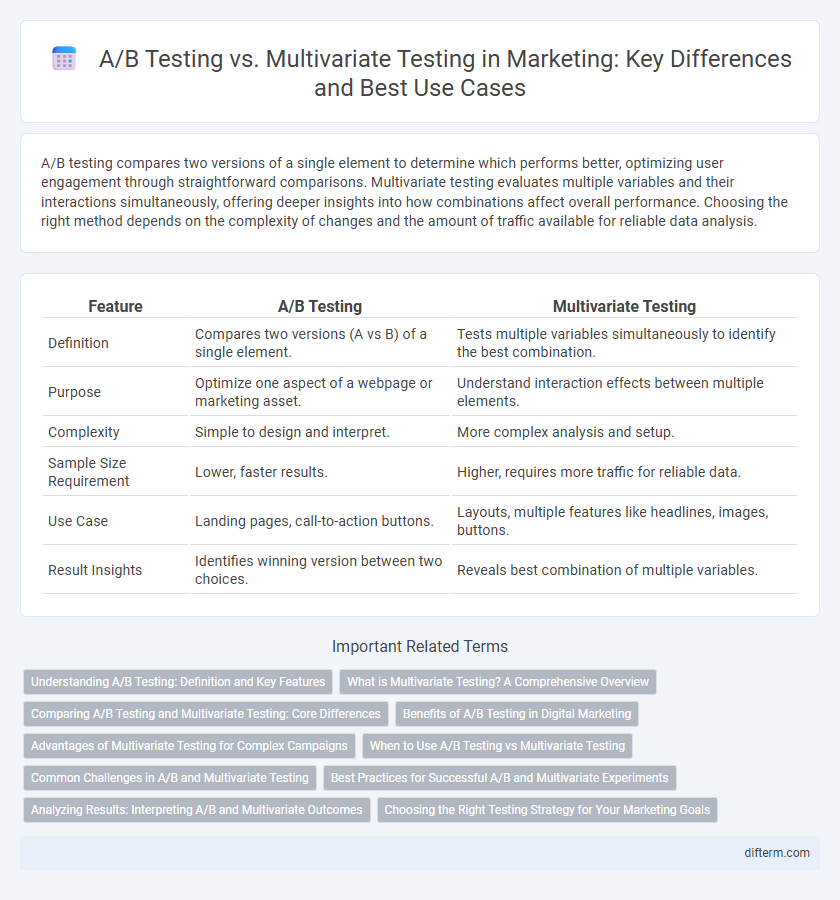A/B testing compares two versions of a single element to determine which performs better, optimizing user engagement through straightforward comparisons. Multivariate testing evaluates multiple variables and their interactions simultaneously, offering deeper insights into how combinations affect overall performance. Choosing the right method depends on the complexity of changes and the amount of traffic available for reliable data analysis.
Table of Comparison
| Feature | A/B Testing | Multivariate Testing |
|---|---|---|
| Definition | Compares two versions (A vs B) of a single element. | Tests multiple variables simultaneously to identify the best combination. |
| Purpose | Optimize one aspect of a webpage or marketing asset. | Understand interaction effects between multiple elements. |
| Complexity | Simple to design and interpret. | More complex analysis and setup. |
| Sample Size Requirement | Lower, faster results. | Higher, requires more traffic for reliable data. |
| Use Case | Landing pages, call-to-action buttons. | Layouts, multiple features like headlines, images, buttons. |
| Result Insights | Identifies winning version between two choices. | Reveals best combination of multiple variables. |
Understanding A/B Testing: Definition and Key Features
A/B testing involves comparing two versions of a marketing asset to determine which performs better based on user engagement metrics such as click-through rates and conversion rates. This method isolates a single variable to identify its impact, ensuring precise insights into consumer behavior. Key features include random audience splitting, statistically significant results, and straightforward implementation, making it an essential tool for data-driven marketing decisions.
What is Multivariate Testing? A Comprehensive Overview
Multivariate testing is a marketing optimization technique that simultaneously tests multiple variables on a webpage to determine the best combination for performance improvement. Unlike A/B testing, which compares two versions of a single element, multivariate testing analyzes interactions between elements like headlines, images, and call-to-action buttons. This advanced approach provides granular insights into which variable combinations significantly impact user engagement, conversion rates, and overall campaign effectiveness.
Comparing A/B Testing and Multivariate Testing: Core Differences
A/B testing compares two variations of a single element to determine which performs better, making it ideal for simple, focused experiments. Multivariate testing evaluates multiple elements simultaneously, analyzing combinations to identify the most effective interaction between variables. Marketers choose A/B testing for clarity and speed, while multivariate testing suits complex campaigns requiring deeper insights into element interactions.
Benefits of A/B Testing in Digital Marketing
A/B testing in digital marketing provides clear, actionable insights by comparing two distinct versions of a webpage or ad, enabling marketers to identify the most effective elements for conversion optimization. This method reduces risk by isolating variables, enhancing decision-making accuracy in campaign adjustments. Marketers benefit from faster implementation and more reliable data, leading to improved user engagement and higher ROI.
Advantages of Multivariate Testing for Complex Campaigns
Multivariate testing enables marketers to evaluate multiple variables simultaneously, providing deeper insights into how different elements interact within complex campaigns. This method offers faster optimization by identifying the most effective combinations of headlines, images, and calls-to-action in a single test, rather than sequentially testing each element. Enhanced data accuracy and comprehensive user behavior analysis make multivariate testing particularly advantageous for refining intricate marketing strategies with numerous components.
When to Use A/B Testing vs Multivariate Testing
A/B testing is ideal for comparing two versions of a single variable, such as a headline or call-to-action, to determine which performs better with clear, measurable outcomes. Multivariate testing suits complex scenarios where multiple elements, like layout, color, and copy, are tested simultaneously to identify the most effective combination of variables. Marketers should choose A/B testing for straightforward, high-impact changes and multivariate testing when optimizing interdependent page elements in a comprehensive marketing campaign.
Common Challenges in A/B and Multivariate Testing
A/B testing and multivariate testing often face challenges such as insufficient sample sizes, leading to inconclusive or statistically insignificant results. Managing the complexity of multivariate testing becomes difficult due to the exponential increase in combinations, which demands longer testing durations and more traffic. Both methods struggle with external factors like seasonality, user behavior fluctuations, and technical issues that can skew test outcomes and reduce reliability.
Best Practices for Successful A/B and Multivariate Experiments
Successful A/B and multivariate testing requires defining clear goals and selecting relevant metrics such as conversion rate, click-through rate, or engagement time to measure performance effectively. Ensuring statistical significance by determining appropriate sample sizes and test durations prevents premature conclusions and increases confidence in results. Implementing rigorous segmentation and controlling for external variables enhances the accuracy of insights, enabling data-driven optimization of marketing strategies.
Analyzing Results: Interpreting A/B and Multivariate Outcomes
Analyzing A/B testing results involves comparing conversion rates between two distinct variants to identify the statistically significant winner, often using metrics like click-through rates and engagement duration. Multivariate testing requires examining multiple combinations of variables simultaneously, applying complex statistical models such as factorial ANOVA to understand individual and interaction effects on user behavior. Accurate interpretation hinges on sample size adequacy, confidence intervals, and p-values to ensure reliable insights that drive data-driven marketing decisions.
Choosing the Right Testing Strategy for Your Marketing Goals
Selecting the ideal testing strategy depends on your marketing goals and the complexity of your variables. A/B testing effectively compares two distinct versions to optimize specific elements like headlines or call-to-actions, providing clear, actionable insights with minimal resource investment. For campaigns involving multiple variables and combinations, multivariate testing uncovers interaction effects and maximizes conversions by analyzing how various changes perform simultaneously.
A/B testing vs multivariate testing Infographic

 difterm.com
difterm.com